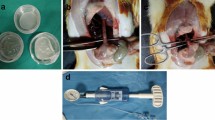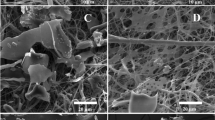Abstract
Large defects in the congenital diaphragmatic hernia (CDH) are treated by prosthetic materials, most frequently polytetrafluoroethylene (PTFE), with high complications. The purpose of this study is to develop a novel electrospun double-faced prosthesis that will minimize these surgical complications. Polyamide 6 (PA-6) and thermoplastic polyurethane (TPU) nanofibers were prepared by solution electrospinning, and room temperature vulcanized silicone (RTV) was used in electrospinning by dip-coating to develop a double-faced membrane. The results demonstrate that the duration of electrospinning and thickness of silicone layers influence the morphology of the bilayer scaffolds. Electrospun bilayer polyamide 6/silicone and thermoplastic polyurethane/silicone scaffolds are fabricated as potential substitutes for prosthetic membrane applications in this study. The morphology, topography, mechanical, and biological properties of these electrospun meshes have been reported to make adequate conclusions in in vitro studies. The morphological characterizations show two distinct layers of electrospun and silicone layer which can mimic the morphology of PTFE prosthesis. However, the mechanical results of the developed TPU/Silicone membrane demonstrate improved mechanical properties. In addition, the biological tests confirm the biocompatibility of the developed prosthesis.
Graphical abstract


















Similar content being viewed by others
References
Coughlin MA, Gupta VS, Ebanks AH, Harting MT, Lally KP, Congenital Diaphragmatic Hernia Study Group (2021) Incidence and outcomes of patients with congenital diaphragmatic hernia and pulmonary sequestration. J Pediatr Surg 56(6):1126–1129
Deeken CR, Thompson DM Jr, Castile RM, Lake SP (2014) Biaxial analysis of synthetic scaffolds for hernia repair demonstrates variability in mechanical anisotropy, non-linearity and hysteresis. J Mech Behav Biomed Mater 38:6–16
Zani A, Zani-Ruttenstock E and Pierro A (2014) Advances in the surgical approach to congenital diaphragmatic hernia. In Seminars in Fetal and Neonatal Medicine (Vol. 19, No. 6, pp. 364–369). WB Saunders.
Saxena AK (2018) Surgical perspectives regarding application of biomaterials for the management of large congenital diaphragmatic hernia defects. Pediatr Surg Int 34(5):475–489
Verla MA, Style CC, Lee TC, Menchaca AD, Lau PE, Mehollin-Ray AR, Fernandes CJ, Keswani SG, Olutoye OO (2022) Does creating a dome reduce recurrence in congenital diaphragmatic hernia following patch repair? J Pediatr Surg 57(4):637–642
Ruhrnschopf CG, Reusmann A, Boglione M, Arbio S, Salas G, Giubergia V, Barrenechea M (2021) Biological versus synthetic patch for the repair of congenital diaphragmatic hernia: 8-year experience at a tertiary center. J Pediatr Surg 56(11):1957–1961
Romao RL, Nasr A, Chiu PP, Langer JC (2012) What is the best prosthetic material for patch repair of congenital diaphragmatic hernia? Comparison and meta-analysis of porcine small intestinal submucosa and polytetrafluoroethylene. J Pediatr Surg 47(8):1496–1500
Schneider A, Talon I, Mathieu E, Schaaf P, Becmeur F, Hemmerle J (2017) New insight in the biological integration of polytetrafluoroethylene from an explant used for diaphragm repair. J Biomater Appl 31(6):844–850
Gasior AC, St Peter SD (2012) A review of patch options in the repair of congenital diaphragm defects. Pediatr Surg Int 28(4):327–333
Grethel EJ, Cortes RA, Wagner AJ, Clifton MS, Lee H, Farmer DL, Harrison MR, Keller RL, Nobuhara KK (2006) Prosthetic patches for congenital diaphragmatic hernia repair: surgisis vs Gore-Tex. J Pediatr Surg 41(1):29–33
Jancelewicz T, Vu LT, Keller RL, Bratton B, Lee H, Farmer D, Harrison M, Miniati D, Mackenzie T, Hirose S, Nobuhara K (2010) Long-term surgical outcomes in congenital diaphragmatic hernia: observations from a single institution. J Pediatr Surg 45(1):155–160
Talon I, Schneider A, Ball V, Hemmerlé J (2020) Functionalization of PTFE materials using a combination of polydopamine and platelet-rich fibrin. J Surg Res 251:254–261
Zhao W, Ju YM, Christ G, Atala A, Yoo JJ, Lee SJ (2013) Diaphragmatic muscle reconstruction with an aligned electrospun poly (ε-caprolactone)/collagen hybrid scaffold. Biomaterials 34(33):8235–8240
Mitchell IC, Garcia NM, Barber R, Ahmad N, Hicks BA, Fischer AC (2008) Permacol: a potential biologic patch alternative in congenital diaphragmatic hernia repair. J Pediatr Surg 43(12):2161–2164
Riehle KJ, Magnuson DK, Waldhausen JH (2007) Low recurrence rate after Gore-Tex/Marlex composite patch repair for posterolateral congenital diaphragmatic hernia. J Pediatr Surg 42(11):1841–1844
Nasr A, Struijs MC, Ein SH, Langer JC, Chiu PP (2010) Outcomes after muscle flap vs prosthetic patch repair for large congenital diaphragmatic hernias. J Pediatr Surg 45(1):151–154
Laituri CA, Garey CL, Valusek PA, Fike FB, Kaye AJ, Ostlie DJ, Snyder CL, Peter SS (2010) Outcome of congenital diaphragmatic hernia repair depending on patch type. Eur J Pediatr Surg 20(06):363–365
Lalia BS, Kochkodan V, Hashaikeh R, Hilal N (2013) A review on membrane fabrication: structure, properties and performance relationship. Desalination 326:77–95
Abdullah N, Yusof N, Lau WJ, Jaafar J, Ismail AF (2019) Recent trends of heavy metal removal from water/wastewater by membrane technologies. J Ind Eng Chem 76:17–38
Tayal E, Chandran AM and Mural PKS (2021) A comparative study of cellulose acetate/polycaprolactone blend electrospun and phase-inversion membranes for forward osmosis. Available at SSRN 4022530.
Hekmati AH, Rashidi A, Ghazisaeidi R, Drean JY (2013) Effect of needle length, electrospinning distance, and solution concentration on morphological properties of polyamide-6 electrospun nanowebs. Text Res J 83(14):1452–1466
Karakaş H, Sarac AS, Polat T, Budak EG, Bayram S, Dağ N, Jahangiri S (2013) Polyurethane nanofibers obtained by electrospinning process. World Acad Sci, Eng Technol 7:498–501
Reddy KR, Raghu AV, Jeong HM (2008) Synthesis and characterization of novel polyurethanes based on 4, 4’-{1, 4-phenylenebis [methylylidenenitrilo]} diphenol. Polym Bull 60(5):609–616
Anancharoenwong E, Chueangchayaphan W, Rakkapao N, Marthosa S, Chaisrikhwun B (2021) Thermo-mechanical and antimicrobial properties of natural rubber-based polyurethane nanocomposites for biomedical applications. Polym Bull 78(2):833–848
Author information
Authors and Affiliations
Corresponding author
Ethics declarations
Conflict of interest
The authors of this paper have no financial or personal relationships with other people or organizations that could inappropriately influence (bias) our work.
Additional information
Publisher's Note
Springer Nature remains neutral with regard to jurisdictional claims in published maps and institutional affiliations.
Rights and permissions
Springer Nature or its licensor (e.g. a society or other partner) holds exclusive rights to this article under a publishing agreement with the author(s) or other rightsholder(s); author self-archiving of the accepted manuscript version of this article is solely governed by the terms of such publishing agreement and applicable law.
About this article
Cite this article
Mohsenzadeh, E., Khenoussi, N., Bölgen, N. et al. Study and development of electrospun (TPU, PA-6) / silicone bilayer membranes for congenital diaphragmatic hernia repair. Polym. Bull. 80, 10309–10333 (2023). https://doi.org/10.1007/s00289-022-04566-8
Received:
Revised:
Accepted:
Published:
Issue Date:
DOI: https://doi.org/10.1007/s00289-022-04566-8




